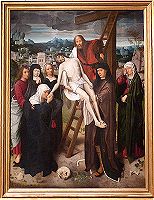 click to enlarge |
THE DESCENT FROM THE CROSSAdriaen Isenbrant SN 199, oil on panel, c 1525 From: "The Pages"
|
ARTIST:
It is thought that Isenbrant may have been born in Antwerp; he died in Bruges. He was married twice; first to Marie Grandeel, who bore him a child who died in 1512. After Marie’s death in 1537, Isenbrant married Clementine de Haerne with whom he had three daughters. One further daughter was born of an extra-marital relationship with the innkeeper Katelijne van Brandenburch. According to contemporary sources, Isenbrant was famous and well to do, and held important posts in the Bruges Guild of Sculptors and Saddlemakers.
He was strongly influenced by Gerard David, and it seems likely that he worked in David’s studio; there are stylistic similarities in their work. Isenbrant was not innovative, & he also referred to such artists as Jan van Eyck, Rogier van der Weyden, Hans Memling, Albrecht Dürer, & Jan Gossart.
The quality of his many works is uneven, even within a single painting which could be explained by studio collaboration. At least once he is known to have repainted works by another artist to suit local taste. His best paintings are small and medium-sized religious scenes. None are signed.
SUBJECT:
The Deposition was a popular subject in 15th and 16th c Flemish painting, although the story is not detailed in the Gospels. It provides a perfect votive image for prayer, since it combines the Gospel story with the visual image of Christ's sacrifice..
The scene is Golgotha, with Jerusalem in the background. Nicodemus, on the ladder, gently lowers Christ’s body to Joseph of Arimathea, who stands at the foot of the cross with his hands supporting Christ’s legs. Mary, in the white coif, kisses her son’s hand. On the left behind Mary, is John, to whose care Jesus committed her. The grieving woman in the black coif is probably Mary, James’ mother. The younger woman in the cap,looking up at Christ, is Mary Magdalen. On the right, weeping and holding two large nails, is probably “the other Mary.” By use of restrained gestures and expressive light, Isenbrant has endowed the scene with exceptional pathos and dignity.
PAINTING:
The composition and main figures are the same as in a Deposition by Gerard David (look here), which is in the Frick Collection in New York. However, Isenbrant has added his own characteristic touches: the cluster of piled-up, vertical mountains, the high horizon line, and the peculiar clouds, some of which look like popcorn balls!
The whole work has a classic gravity previously seen only in Italian work with the typically Renaissance integration of figures and rational landscape. The city, of course, looks more like one in Flanders than it does Jerusalem.
The color scheme is generally warm, almost rosy – except for that menacing blue, aqua, & gray sky about to deliver the dread storm over them all. It is in this almost surreal background that the new idiom of Mannerism is most evident. Background depth is suggested , but it’s still somewhat out of kilter and plane.
The old traditional Flemish realism is present in the detailed clothing and faces, as well as the delicately painted plants and trees.
There are 2 triangles, giving us Renaissance stability:
- the actual one, formed by the ladder & cross,
- the suggested one formed by the light & color moving the eye from John’s gray cloak, up Mary’s
white coif to the drape on Nidodemus’ shoulder, down through Christ’s legs to the ermined edge
of Joseph’s cloak.
So the painting gives us this moving, visual display of Christ’s torment, & the symbolism tells the viewer that redemption is central to Christianity as well as the thinking of the time.
HISTORIC CONTEXT:
At the time of this painting, Bruges painters often worked for the art market and for export. Such commercialism was not conducive to complete stylistic unity within a painter’s oeuvre.
The conspicuous display of Christ’s body was an appropriate subject for an altarpiece, not only as an aid to devotion & meditation on His sacrifice, but also because it mirrors the priest’s offering of the Host in mass.
A typical memento mori is the skull in Dürer’s etching of Jerome in his study. Or, an entire painting can be a memento mori such as the Vanitas by Peter Claesz (1623), an oil on wood in the Metropolitan, NY.
During the Renaissance, a small ornament in the shape of a skull was often carried, usually finely crafted and often jeweled.